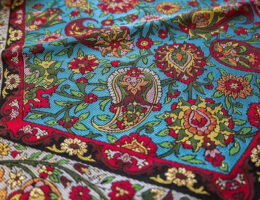IRAN ART EXHIBITION: KILIM WEAVING IS AN ANCIENT ART
Weaving has been one of the initial arts and industries of different mankind tribes. There are evidences proving the existence of rug and Kilim in ancient civilizations of Persian plateau.
The history of appearance of rug weaving in Iran dates back to 1500 to 2000B.C. while the history of appearance of Kilim weaving in Iran reaches to 3000B.C. which is considered as the initial time of textile industry in Iran. Weaving Kilim and Jajim (a woolen cloth) has been an introduction on appearance of rug weaving. Kilim is a kind of carpet without any lint which is knitted by tying warp and woof.
Usually the warp of Kilim is made of cotton, wool or silk; and the woof is often wool or silk which are all used in different colors. This carpet has got many names in Persian language but in Caucasus they call it “Bedas” and in Syria and Lebanon it is named “Liat”. In Romania it is called “Chilim” and in Turkey, Poland, Hungary and Saudi Arabia they call it “Kilim”.
According to archeology discoveries some evidences have been discovered which represents in Persian plateau and the adjacent lands there have been weaving 8000 years ago; for example in southeast caves of Mazandaran (Kamarband and Hutu cave near Behshahr city) some evidences have been found which shows that people of this region have been growing sheep and goats and spinning wools of these animals. Also a piece of cloth made of goal wool has been found near Caspian Sea with antiquity of 8000 years, also a linen cloth with antiquity of 6000 years was found in Shush.
Despite all these evidences, we cannot find an accurate initiating time for Kilim. If we consider the initiating time of rug weaving – based on Pazirik discovery- 1500 to 2000 BC we can declare that the initiating time of Kilim weaving has been 3000 to 5000 BC.
IRAN ART EXHIBITION: Kilim is being weaved in different parts of Iran and the distinction of Kilim is based on the region and the type of Kilim. Each region – according to its taste and feelings- creates an especial design and color for Kilim. Different kinds of Kilims and their production places are as the following:
Shirikipich weaved in villages and by nomads of Kerman.
Verni weaved in Maghan plain and by nomads of Ahar vicinity
Arsbaran weaved in Meshkin shahr of eastern Azerbaijan province
Gelimche weaved in Bijar and neighboring villages of Sanandaj
Zilo which is mostly weaved by cotton and is used as a summer carpet
Palas or Yalas which is weaved in Yazd
Masnad weaved in villages of Namin district of Ardebil province
Jal which is used as a dress for pack animals or as a prayer cloth
Ensy which is used for tying the furniture or is used for packing blankets and quilts
Javal which is weaved in the form of a bag and nomads use it for storing the foods.
A kilim (Azerbaijani: Kilim کیلیم; Turkish: Kilim; Turkmen: Kilim; Persian: گلیم Gilīm) is a flat tapestry-woven carpet or rug traditionally produced in countries of the former Persian Empire, including Iran, the Balkans and the Turkic countries. Kilims can be purely decorative or can function as prayer rugs. Modern kilims are popular floor coverings in Western households.

Weaving technique
Diagram of kilim slit weave technique, showing how the weft threads of each color are wound back from the color boundary, leaving a slit
Kilims are produced by tightly interweaving the warp and weft strands of the weave to produce a flat surface with no pile. Kilim weaves are tapestry weaves, technically weft-faced plain weaves, that is, the horizontal weft strands are pulled tightly downward so that they hide the vertical warp strands.
When the end of a color boundary is reached, the weft yarn is wound back from the boundary point. Thus, if the boundary of a field is a straight vertical line, a vertical slit forms between the two different color areas where they meet. For this reason, most kilims can be classed as “slit woven” textiles. The slits are beloved by collectors, as they produce very sharp-etched designs, emphasizing the geometry of the weave. Weaving strategies for avoiding slit formation, such as interlocking, produce a more blurred design image.
IRAN ART EXHIBITION: The weft strands, which carry the visible design and color, are almost always wool, whereas the hidden warp strands can be either wool or cotton. The warp strands are only visible at the ends, where they emerge as the fringe. This fringe is usually tied in bunches, to ensure against loosening or unraveling of the weave.






